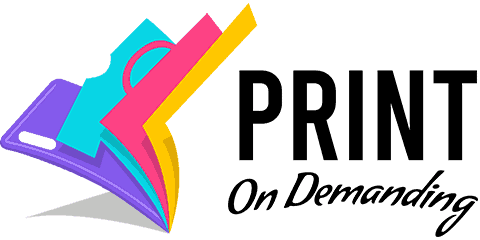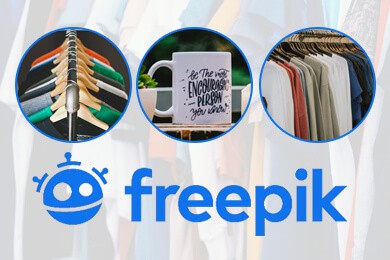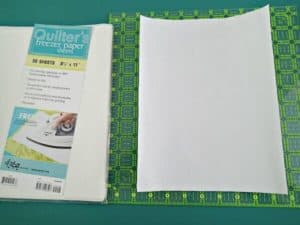
Deciding what to print on a t-shirt, mug, pen, or other item is hard. If you’re not artistically inclined, you might want to use preexisting vector art or stock photos like those on Freepik. Can you also rely on Freepik for printing on demand?
Freepik provides stock photos and vector art for free, and you can upload your own pieces, but the site does not have any printing options. Also, Freepik enforces strict rules about using its art for third-party printing on demand, as their art has to not be the focal point of the piece.
If you want to learn more about Freepik, then we recommend you keep reading. In this article, we’ll dive into which services Freepik does and doesn’t offer. We’ll even talk about the legalities of reproducing Freepik art for printing and selling. You won’t want to miss it.
What Is Freepik?
Freepik is an image services website that specializes in Photoshop image files (PSDs), stock photos, and vector art. As the name implies, images are available for free, although Freepik does have paid premium features.
You don’t even need a Freepik membership to begin using the site. You can simply click on the link above and browse for whatever you’re looking for. Freepik lets you search all its resources, or you can look for a specific resource you want.
You can also comb through a slew of Freepik offerings right on their homepage, organizing these by PSD, photos, vectors, or Freepik’s Choice.
Freepik even allows you to become a contributor, providing your own original art and photos to be downloaded. Contributors have the chance to earn money from their work. We say “have a chance” because it’s not guaranteed. You’d have to have someone pay to use your photo/vector, and then you earn a cut for each download after Freepik gets its pay.
As a contributor, Freepik mentions that you’re under a non-exclusive agreement. This means you can sell your artwork on other sides that are also considered microstock, so sites in the same vein as Freepik that sell stock photography. You’re free of deadlines as well so you can work within a schedule that’s best for you.
Here’s a video of an artist creating a logo for Freepik, which you can watch on YouTube:
Freepik mentions that 40 million people have the potential to see your art, as that’s how many monthly visitors their site gets. As your library of artwork and resources grows, you have the potential to earn more money.
As we said before, not everything on Freepik is free. By paying to use Freepik to download premium images, have can either pay a monthly fee of $11.99 or you can join for a year. For that membership, you’re charged $8.25 a month. That’s $99 annually.
Your paid membership gets you ad-free browsing, priority support, and as many downloads as you want. You also gain access to more than 117,000 premium PSD files, over 3.6 million premium stock photos, and more than 2.3 million premium vectors.
Can You Use Freepik for Print on Demand?
While Freepik’s services are extensive, if you’re looking to print any of the cool artwork and vectors you find on their site on-demand, you’re out of luck. Freepik offers images only, no means to print them.
If you’re paying for a membership on Freepik, then you’re going to want to choose a more inexpensive printing service for your found artwork. In that case, we wouldn’t recommend something like Printful or even CaféPress or Zazzle, as these are known for being quite costly print-on-demand services.
That said, if you’re only going with the free images available in Freepik’s library, then you might not mind spending a bit more for your printing. It’s ultimately your choice.
Is It Legal to Sell Goods with Freepik Art on Them?
For the rest of this article, we’ll discuss the legalities of taking art from Freepik and selling it elsewhere. Given that Freepik itself isn’t a print-on-demand service, it’s expected that the art produced for this site might show up in other places online.
In our first scenario, you found an awesome artwork or vector on Freepik. Maybe this is something you made yourself or it’s someone else’s work. You can already envision it as an art print or on a sweatshirt, but the question becomes, can you legally sell this art from Freepik?
On the Freepik Premium page, they have an FAQ section. The first question is “can I use downloaded content to create work for a client?” That sounds like about the same topic we’re discussing now. So what does Freepik say?
“Yes, you can use our images for our clients,” but Freepik also notes the usage must meet the rules the site has established. The Freepik Usage Guide covers everything from using Freepik art as templates, in games and art, in books and press releases, as a YouTube thumbnail, on websites and blogs, on social media, for packaging and logos, for print-on-demand, and for personal use.
We won’t cover all the usage rules for each category, as they’re not applicable. Instead, we’ll talk about Freepik’s rules for reproducing their art for print-on-demand.
Print-on-Demand
Freepik relaxes the rules for their print-on-demand a lot more than for some of the other above options, such as using vectors or art for logos.
Under the Usage Guide, you’re excluded from using the main element of a Freepik design for printing.
Okay, but what is the main element? Freepik differentiates between main and secondary elements on another page on their site. The main element is the Freepik image itself, untouched and unaltered.
A secondary element is any element added to the piece that’s now bigger in focus than the main element. It doesn’t necessarily have to come from Freepik, either.
Here’s what Freepik says specifically about printing their designs on items like sweatshirts, tees, and mugs: “…you must use your own designs or third-party designs to create the main elements of the composition and use Freepik images as backgrounds or secondary elements.”
You also can’t use more than one Freepik vector or image, as Freepik says at that point, they’re all counted as the main element.
That was a lot of information, but here’s how it breaks down. If you use elements like a background image or another image that’s not the focal point, then it’s okay to print something with a Freepik image or vector. If the Freepik art is front and center, then it’s considered the main element and you can’t legally use it for printing.
Can You Legally Modify Freepik Art and Then Sell It?
Here’s another scenario for you. You were searching around on Freepik and again came across some really great art. The only difference between this situation and the last one is that this time, you think the art is missing a little something. If you could get your hands on it and fix it up a bit, it would be even better. Then you’d be happy to sell it for print on a t-shirt or hoodie.
Is this legally allowed? Freepik is actually pretty generous about allowing you to take images and vectors from their site and use them in modified artwork. That said, depending on what you want to do to the art, you may or may not be able to print it and sell it on goods.
This again comes back to the main element and secondary element classification. Freepik is very specific that even if you swap the orientation or the color of an image that it’s still considered the primary element. In fact, they call those “small changes.” So it’s not enough to flip an image from facing left to right and then making it purple from orange.
You also have to watch the sizing of other elements, even if they come from third parties. Freepik notes in its Usage Guide that if the Freepik design “attracts the attention before the other parts of the design,” that has more weight. This means that even if it’s not necessarily the focal point, it’s still considered the main element and therefore, you can’t use the design for printing.
Even if you found a blank or simple background on Freepik and you wanted to modify it by adding some text, you must tread carefully. Again, Freepik mentions talk about weigh in relation to background images. The background must not have as much weight as the text. Freepik cites abstracts and watercolors as good examples of backgrounds in which the weight may be less than that of the text.
Backgrounds with illustrations or frames will almost always outweigh the text. In that case, you’d probably want to skip this background altogether, as the image would require too many changes to qualify as a secondary element.
Even if you find a pattern that you could theoretically use as a secondary element, Freepik states that you can’t print wrapping paper, notebooks, or clothes with this pattern, as it’s then considered the main element, not a secondary one.
Conclusion
Freepik is a website that offers PSD files, vectors, and stock photos. Most are available for free, but there’s also a premium service. You can work as a contributor on Freepik as well, selling your artwork here. While Freepik does no print itself, the company does have a strict set of rules for selling printed goods with the site’s artwork. These need to be a secondary element and never the main one. You can modify Freepik art and then sell it, but again, there are rules to follow for doing so.




